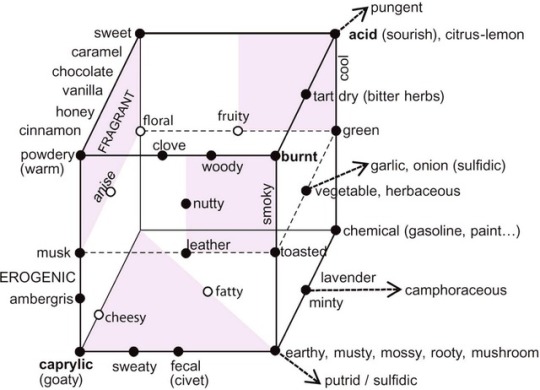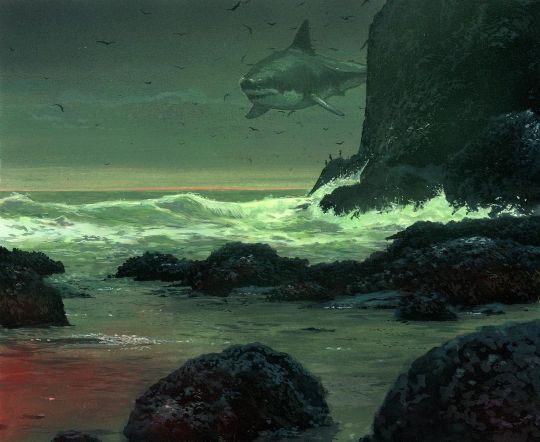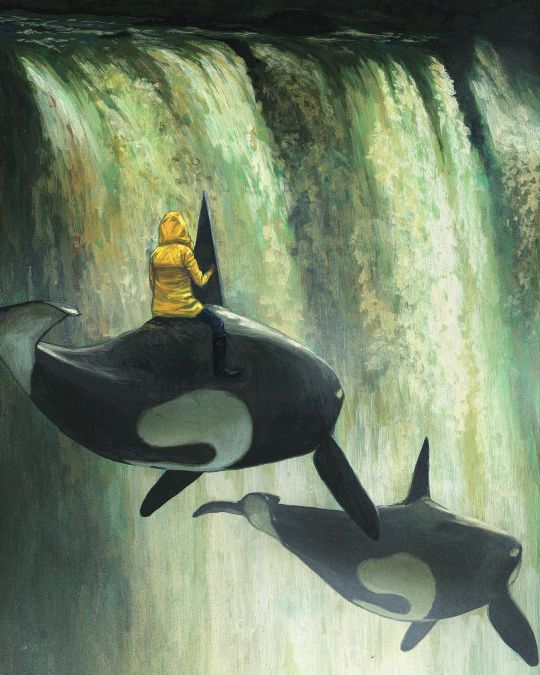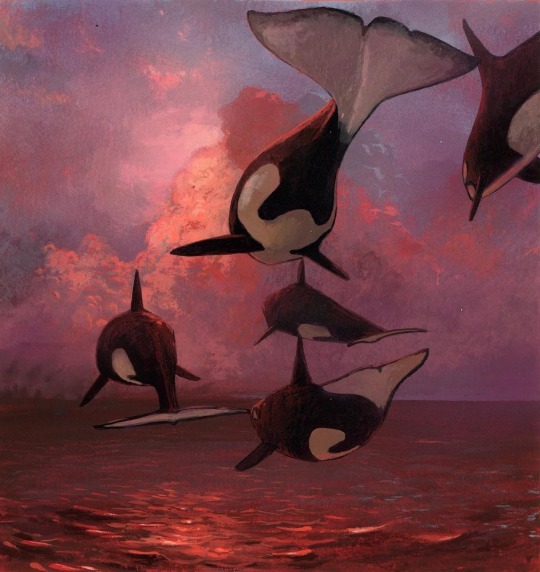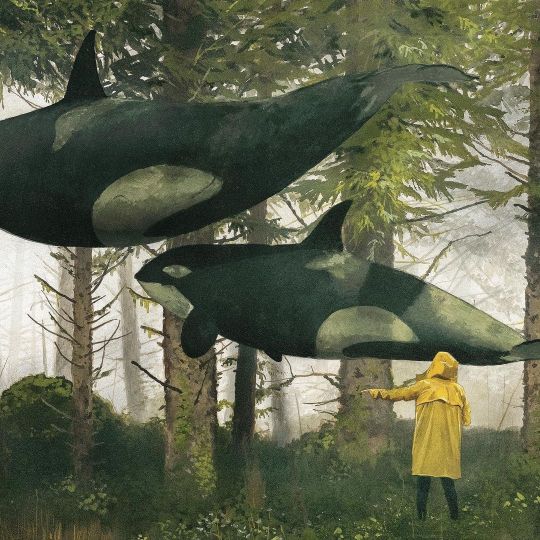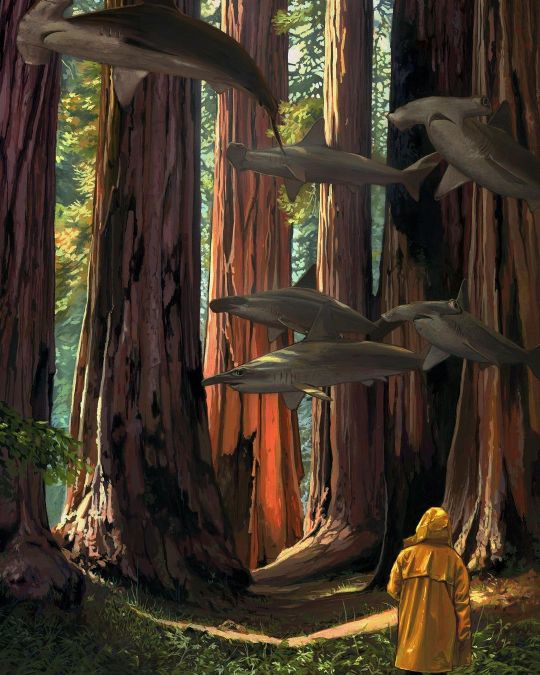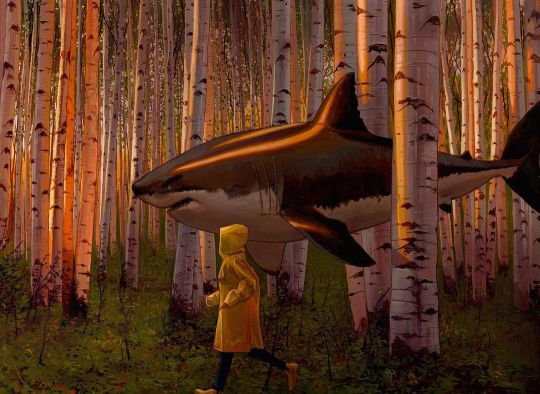Paleoart, memes, science, sci-fi and art. Aspiring paleontologist. Hmu with paleoart and fossil pics and we’ll be eternal friends.
Don't wanna be here? Send us removal request.
Text
Trailcam: Rhynie Chert biota, fossil deposit known for it's very detailed fossils of plants and invertebrates due to them being petrified by volcanic hot springs, around 410 million years ago in the early Devonian.
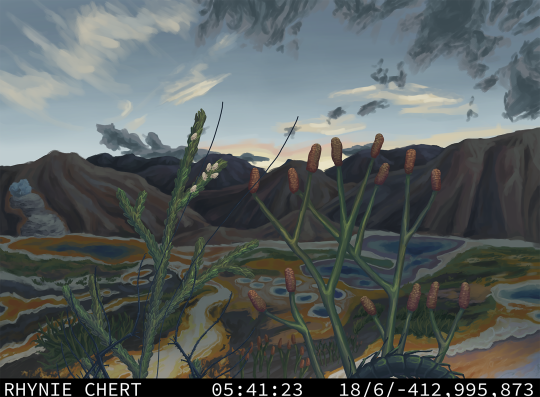

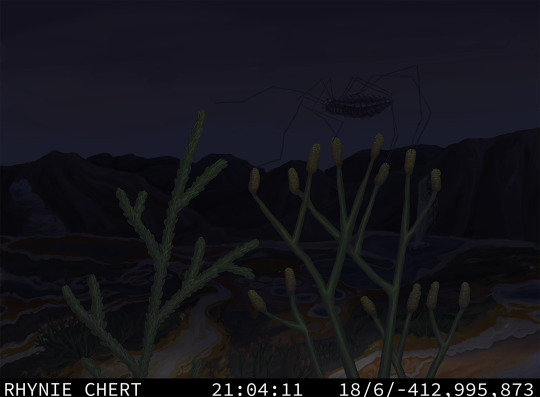
[Image description: A series of digital illustrations of a geothermal landscape with blue and orange geothermal pools and clusters of green plants, with brown mountains in the background. In the front of the image, there are 2 plants close up. Image 1: At dawn, a Crussolum centipede, a dark blue centipede with long thin legs, reaches up to climb the plant on the left, which has some small Protacarus crani mites, appearing as small pale dots, climbing on the top. Part of a Leverhulmia mariae myriapod, looking like dark green millipede or centipede, is visible at the base of the second plant. Image 2: As a storm approaches in the day, an orange Palaeocharinus rhyniensis trigonotarbid, a small arachnid that looks like a spider with a flat, segmented abdomen and more small eyes, eats a small bluish white Lepidocaris rhyniensis crustacean, it caught from the edge of a drying up pool. Image 3: At night, Eophalangium sheari, a harvestman, is silhouetted against the sky as it climbs over the plants.]
451 notes
·
View notes
Text
the massive power of trains yet confinement to a single path makes them comparable to angels
118K notes
·
View notes
Text

Inostrancevia was neither a reptile nor a mammal, but rather a therapsid. It lived during the late Permian period about 240-260 million years ago.
Colors inspired by the Thylacine
433 notes
·
View notes
Photo

Morris Graves (American, 1910-2001), Minnow, 1954. Gouache and watercolor on paper, 6 x 8.75 in.
365 notes
·
View notes
Photo

Even for a fossil species from an isolated island, Adalatherium hui is very weird.
This mammal was part of an enigmatic group known as gondwanatheres, which were probably early members of the theriiform lineage – slightly closer related to modern marsupials and placentals than to monotremes. Found in the southern continents of Gondwana between the Late Cretaceous and the Miocene, these animals were adapted for herbivory with convergently rodent-like ever-growing front teeth that helped them chew through tough plant matter.
They were previously known mainly from isolated teeth and jaw fragments, with some rare full skull material, but Adalatherium is remarkable for being represented by a complete skeleton.
And it’s turned out to be far stranger than anyone expected.
Living in northwestern Madagascar during the Late Cretaceous, about 70-66 million years ago, Adalatherium was one of the larger known Mesozoic mammals at around 60cm long (2’) – although the one known specimen seems to have been a juvenile, so mature individuals were probably slightly larger.
(And based on its body proportions, its close relative Vintana may actually have been even bigger than previously thought. Whether this sort of large size was common in Cretaceous gondwanatheres or if this was just island gigantism is still unknown, though.)
It was probably a marmot-like digging animal, excavating burrows with its large claws and powerful limbs, and since it likely evolved from ancestors that had become isolated on Madagascar over 20 million years earlier it had developed a very unusual mixture of both “primitive” and highly specialized anatomical features. It had more back vertebrae than any other known Mesozoic mammal, upright forelimbs, sprawling hind legs with bowed-out tibias, strong back and leg musculature, and a therian-like pelvis with epipubic bones.
And then there’s the snoot.
The snout region of Adalatherium’s skull was pockmarked with a large number of foramina, holes that allow the passage of nerves and blood vessels through the bone. It had more of these than any other known mammal, and their presence suggests that it probably had a very sensitive upper lip and whiskery snout. Most mammals with a lot of whiskers just have one very big foramina, but Adalatherium seems to have evolved a different solution to the same problem.
It also had one other bizarre feature – a hole in the top of its nose. A large “internasal vacuity” between its nasal bones is a unique feature not known in any other mammal, and its function is a total mystery.
Since this hole was also surrounded by many foramina it may have supported some sort of soft-tissue sensory structure on top of its nose. So I’ve speculatively depicted it here with a leathery horn-like “shield”.

[ From fig 2 in Krause, D. W. et al (2020). Skeleton of a Cretaceous mammal from Madagascar reflects long-term insularity. Nature 581, 421–427. https://doi.org/10.1038/s41586-020-2234-8 ]
———
Nix Illustration | Tumblr | Pillowfort | Twitter | Patreon
238 notes
·
View notes
Photo

Terrain map of Middle-Earth from Lord of the Rings.
by u/numante
394 notes
·
View notes
Photo



I bought a fun little travel pack of watercolours, so here’s some sketches of Morrison Formation sauropods! Supersaurus and Camarasaurus, observed in the field
822 notes
·
View notes
Photo


A ‘Spanish dancer’ sea slug (Hexabranchus sanguineus) has been spotted putting on a vibrant display along the coast of Western Australia. The large droid nudibranch has a soft and flattened body and can grow to a maximum length of 90cm, although they are more commonly 20 to 30cm. The Spanish dancer is found throughout the Indo-Pacific, including around Australia, near Japan, Hawaii and parts of the east coast of Africa, with a penchant for rocky and coral reefs. (Source)
Follow us on Telegram https://t.me/thefabulousweirdtrotters
23K notes
·
View notes



